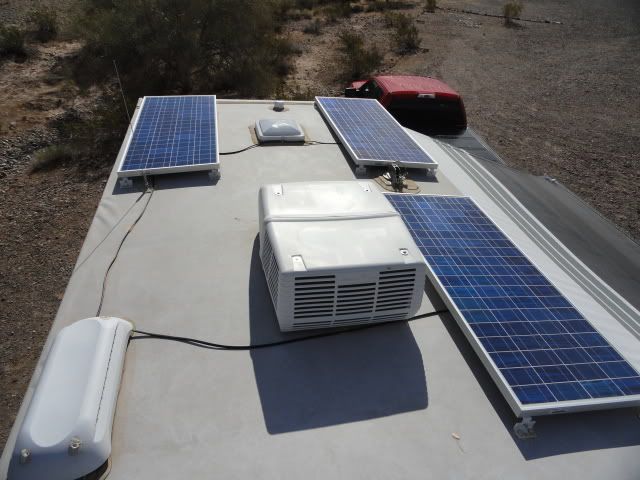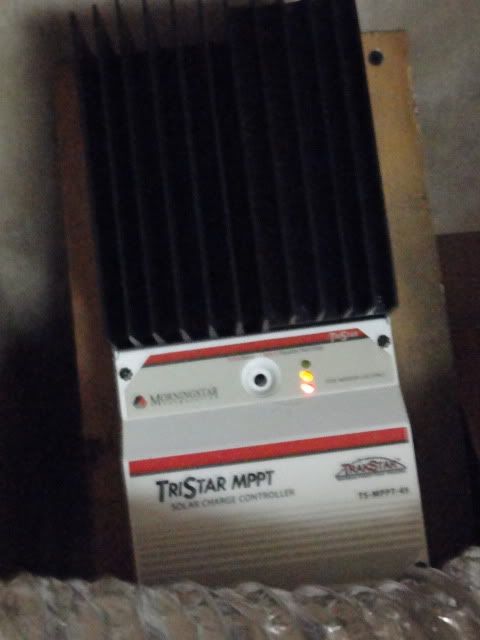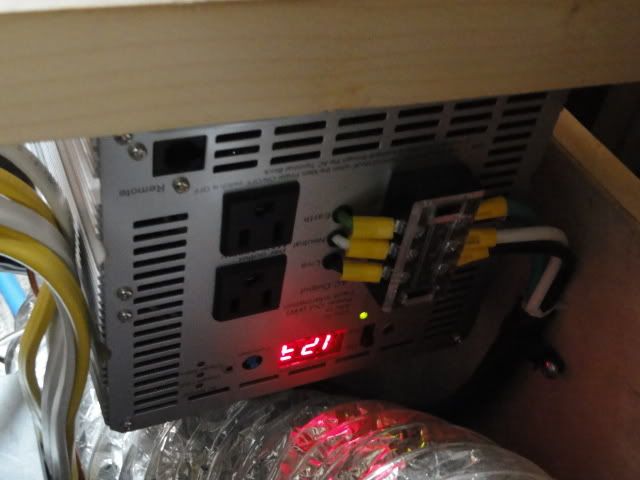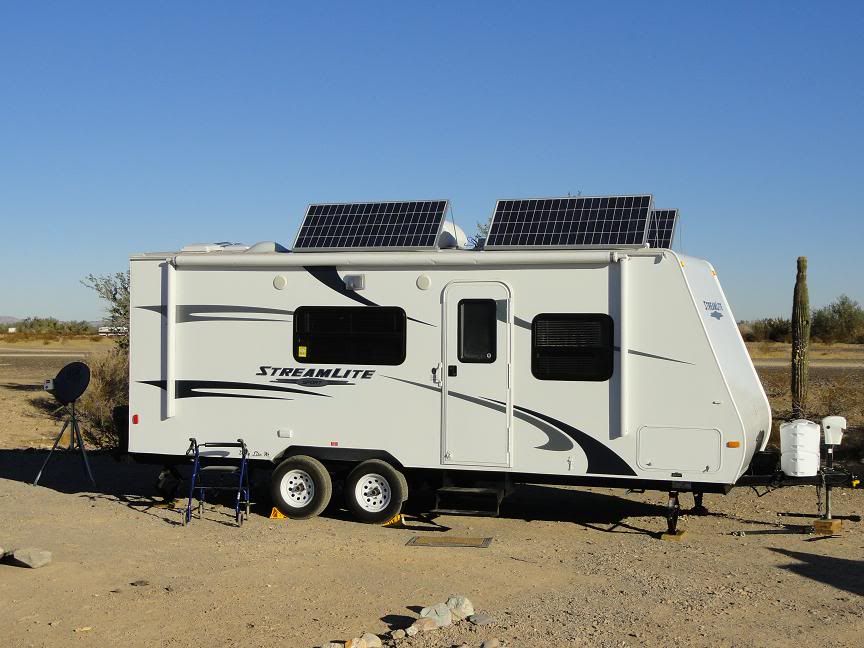JustCause
Inactive
I'm in the process of designing and building a solar system to power my travel trailer (could double as a bug-out-trailer). Hours and hours of research into the project, and I have become fascinated with the resource. I think there could be a very promising future for solar power as the advancements continue.
----------------------------------------------------------------------------------------------
http://tinyurl.com/3ju4foe
5 breakthroughs that will make solar power cheaper than coal
Solar technology charges forward despite Washington's backward march.
Mon, Aug 08 2011 at 4:12 AM EST 17
Photo: Echo Energies
There was some good news last week. While Washington was busy holding the global markets hostage and placing billions in badly needed R&D funding on the chopping block, a new report from REN21 (the Renewable Energy Network for the 21st Century) showed that global investments in renewable energy jumped 32 percent to a record $211 billion, this despite a downturn in the economy and massive R&D cuts in clean energy.
It's a little reassuring that progress marches forward, despite our nation's best efforts to stop it. Solar in particular appears to be growing in leaps and bounds due in large part to a 60 percent drop in price per kW (kilowatt) production in just the past three years. In many regions solar power is getting competitive with coal power, and its price will continue to drop with the onset of a many new advancements in solar technology.
I've been keeping abreast of the latest solar developments happening at MIT, and over the past few months scientists appear to be having one breakthrough after another. Below I've listed five of the most impressive — taken together, these could mean nearly infinite solar energy, stored easily and safely at a fraction of the cost of burning coal:
1. Nano-templated molecules that store energy
MIT associate professor Jeffrey Grossman and others successfully created a new molecule called azobenzene using carbon nanotubes to structure the molecules so that they "lock in" stored solar thermal energy indefinitely. These molecules have the remarkable ability to convert solar energy and store it at an energy density comparable to lithium ion batteries. As Grossman says, "You’ve got a material that both converts and stores energy. It’s robust, it doesn’t degrade, and it’s cheap.”
2. Print solar cells on anything
An MIT team led by professor Karen Gleason has discovered a way to print a solar cell on just about anything, using low temperatures and vapor as opposed to liquid solutions that are expensive, require high temperatures and degrade the substrate materials. The resulting printed paper cell is also extremely durable and can be folded and unfolded more than 1,000 times with no loss in performance.

Photo by Patrick Gillooly, Courtesy of MIT
3. Solar thermal power in a flat panel
Professor Gang Chen has been working on a revolutionary new way to make solar power — micro solar thermal — which could theoretically produce electricity at 8 times the efficiency of the word's best solar panel. Solar thermal usually requires huge arrays of mirrors that heat up an element to run a steam turbine. Chen's system, which is about the size and shape of a typical solar PV panel, uses nanostructured thermoelectric generators that capture the heat differential created by the sun's light striking the top of the panel. Because it is a thermal process, the panels can heat up from ambient light even on an overcast day, and these panels can be made from very inexpensive materials.
4. A virus to improve nano-solar cell efficiency
MIT graduate students recently engineered a virus called M13 (which normally attacks bacteria) that works to precisely space apart carbon nanotubes so they can be used to effectively convert solar energy. The virus acts, in a sense, as a tiny machining tool to pattern the nanotubes properly creating a jump from about 8 percent efficiency to 10.6 percent efficiency — a jump of nearly one-third.
5. Transparent solar cell could turn windows into power plants
The world's cities are packed with miles and miles of glass. What if all that glass could be used to harness the sun's rays while maintaining their transparency? This idea has been out there for a while, but current attempts have resulted in terrible efficiencies (less than 1 percent) and tend to block too much light, rendering the window useless. Electrical engineering professor Vladimir Bulovic has made a breakthrough that could eliminate two-thirds of the costs of installing thin-film technology by incorporating a layer of new transparent organic PV cells into the window glazing. The MIT team believes it can reach a whopping 12 percent efficiency at hugely reduced costs over thin film solar cells.
This is the stuff that Star Trek is made of, and it's a shame that our elected leaders see little value in spurring the next generation of energy tecnology rather than preserving tax cuts for oil and coal companies who are currently making record profits while spending millions on Capitol Hill to fight the very incentives that would unlock a 21st century energy revolution.
----------------------------------------------------------------------------------------------
http://tinyurl.com/3ju4foe
5 breakthroughs that will make solar power cheaper than coal
Solar technology charges forward despite Washington's backward march.
Mon, Aug 08 2011 at 4:12 AM EST 17
Photo: Echo Energies
There was some good news last week. While Washington was busy holding the global markets hostage and placing billions in badly needed R&D funding on the chopping block, a new report from REN21 (the Renewable Energy Network for the 21st Century) showed that global investments in renewable energy jumped 32 percent to a record $211 billion, this despite a downturn in the economy and massive R&D cuts in clean energy.
It's a little reassuring that progress marches forward, despite our nation's best efforts to stop it. Solar in particular appears to be growing in leaps and bounds due in large part to a 60 percent drop in price per kW (kilowatt) production in just the past three years. In many regions solar power is getting competitive with coal power, and its price will continue to drop with the onset of a many new advancements in solar technology.
I've been keeping abreast of the latest solar developments happening at MIT, and over the past few months scientists appear to be having one breakthrough after another. Below I've listed five of the most impressive — taken together, these could mean nearly infinite solar energy, stored easily and safely at a fraction of the cost of burning coal:
1. Nano-templated molecules that store energy
MIT associate professor Jeffrey Grossman and others successfully created a new molecule called azobenzene using carbon nanotubes to structure the molecules so that they "lock in" stored solar thermal energy indefinitely. These molecules have the remarkable ability to convert solar energy and store it at an energy density comparable to lithium ion batteries. As Grossman says, "You’ve got a material that both converts and stores energy. It’s robust, it doesn’t degrade, and it’s cheap.”
2. Print solar cells on anything
An MIT team led by professor Karen Gleason has discovered a way to print a solar cell on just about anything, using low temperatures and vapor as opposed to liquid solutions that are expensive, require high temperatures and degrade the substrate materials. The resulting printed paper cell is also extremely durable and can be folded and unfolded more than 1,000 times with no loss in performance.

Photo by Patrick Gillooly, Courtesy of MIT
3. Solar thermal power in a flat panel
Professor Gang Chen has been working on a revolutionary new way to make solar power — micro solar thermal — which could theoretically produce electricity at 8 times the efficiency of the word's best solar panel. Solar thermal usually requires huge arrays of mirrors that heat up an element to run a steam turbine. Chen's system, which is about the size and shape of a typical solar PV panel, uses nanostructured thermoelectric generators that capture the heat differential created by the sun's light striking the top of the panel. Because it is a thermal process, the panels can heat up from ambient light even on an overcast day, and these panels can be made from very inexpensive materials.
4. A virus to improve nano-solar cell efficiency
MIT graduate students recently engineered a virus called M13 (which normally attacks bacteria) that works to precisely space apart carbon nanotubes so they can be used to effectively convert solar energy. The virus acts, in a sense, as a tiny machining tool to pattern the nanotubes properly creating a jump from about 8 percent efficiency to 10.6 percent efficiency — a jump of nearly one-third.
5. Transparent solar cell could turn windows into power plants
The world's cities are packed with miles and miles of glass. What if all that glass could be used to harness the sun's rays while maintaining their transparency? This idea has been out there for a while, but current attempts have resulted in terrible efficiencies (less than 1 percent) and tend to block too much light, rendering the window useless. Electrical engineering professor Vladimir Bulovic has made a breakthrough that could eliminate two-thirds of the costs of installing thin-film technology by incorporating a layer of new transparent organic PV cells into the window glazing. The MIT team believes it can reach a whopping 12 percent efficiency at hugely reduced costs over thin film solar cells.
This is the stuff that Star Trek is made of, and it's a shame that our elected leaders see little value in spurring the next generation of energy tecnology rather than preserving tax cuts for oil and coal companies who are currently making record profits while spending millions on Capitol Hill to fight the very incentives that would unlock a 21st century energy revolution.
Last edited:




 ) I Bought it at the inverter store works great! Will even run the A/C for 45min. before draining the batteries... I've run it on occasion for 1/2 hr. with no problems.
) I Bought it at the inverter store works great! Will even run the A/C for 45min. before draining the batteries... I've run it on occasion for 1/2 hr. with no problems.








 He was the only one available at the time so I made him read the instructions, three times.
He was the only one available at the time so I made him read the instructions, three times.  I now have had two solar tubes in my north face kitchen ceiling since 2002, without issue, despite being installed by a construction/building incompetent. DS is quite proud but still calls to check on them every time it rains.
I now have had two solar tubes in my north face kitchen ceiling since 2002, without issue, despite being installed by a construction/building incompetent. DS is quite proud but still calls to check on them every time it rains.
